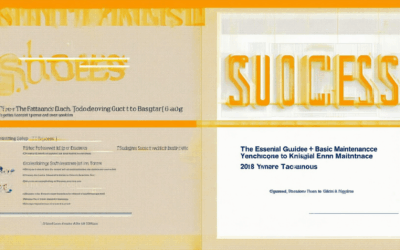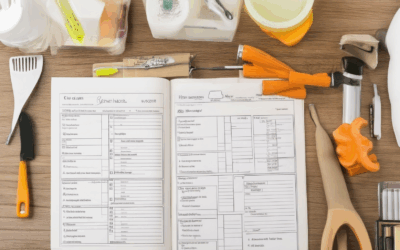Maintaining a healthy home requires a strategic approach, and one of the most effective ways to stay proactive is by embracing a routine of essential monthly repair projects. Whether you’re a homeowner looking to preserve your property’s value or a renter aiming to avoid unexpected costs, neglecting routine maintenance can lead to bigger issues down the line. From checking for leaks to inspecting appliances, these projects are designed to prevent small problems from becoming major headaches. In this comprehensive guide, we’ll explore everything you need to know about creating a home maintenance routine that works for you, your family, and even your kids. By setting aside time each month for these essential tasks, you’ll not only save money but also ensure your living space remains safe and comfortable year-round.
Key Takeaways
– Monthly Checks: Inspect for leaks in pipes, faucets, and appliances to prevent costly repairs. Clean debris from gutters and downspouts to maintain proper drainage. Test smoke detectors and carbon monoxide alarms to ensure your home’s safety.
– Quarterly Tasks: Service HVAC systems annually, but check filters monthly to optimize efficiency. Examine foundations for cracks or signs of movement. Trim trees and bushes to keep your property looking tidy and safe.
– Annual Services: Replace air filters and perform duct cleaning to improve indoor air quality. Check for termite infestations and pest control needs to protect your home. Service major systems like plumbing, electrical, and HVAC to ensure everything runs smoothly.
– Seasonal Maintenance: Prepare for each season by cleaning gutters in spring, inspecting pool equipment in summer, raking leaves in fall, and clearing snow in winter.
– Professional Inspections: Hire experts to inspect for structural issues, mold, and pests annually. Have chimneys and flues checked by a certified technician and replace shingles as needed to maintain your home’s integrity.

Example of a Maintenance Project
A maintenance project is a planned activity focused on preserving, extending, or restoring the useful life of an asset, such as a building, piece of equipment, or property. Here’s an example:
- Residential Home Maintenance Project
- Painting Exterior Walls – Refreshing the exterior paint job to prevent peeling and maintain curb appeal.
- Gutter Cleaning and Repair – Removing debris and fixing leaks to prevent water damage.
- Landscaping and Yard Maintenance – Trimming trees, mowing grass, and installing new plants to keep the property looking neat and healthy.
- HVAC System Service – Inspecting and servicing the heating and cooling system to ensure optimal performance and energy efficiency.
- Appliance Maintenance – Cleaning and lubricating appliances like refrigerators, dishwashers, and ovens to extend their lifespan.
- Commercial Building Maintenance Project
- Roof Repairs and Maintenance – Fixing leaks and replacing damaged shingles to protect the building and its occupants.
- Plumbing System Renovation – Upgrading outdated pipes and fixtures to improve water efficiency and functionality.
- Electrical System Rewiring – Updating electrical systems to meet modern safety standards and reduce energy consumption.
- Fire Safety Systems Installation – Installing fire alarms, sprinklers, and smoke detectors to enhance property security.
- Industrial Machinery Maintenance Project
- Lubrication and Oil Changes – Ensuring smooth operation of heavy machinery through regular lubrication and oil replacement.
- Belting and Hose Replacement – Replacing worn belts and hoses to prevent mechanical failures and downtime.
- Pump Maintenance – Servicing pumps to maintain pressure and ensure consistent performance in production processes.
Budgeting for Monthly Home Repairs
Creating a budget for home repairs is essential to avoid financial stress and ensure timely maintenance. Here’s a step-by-step guide to help you plan effectively:
- Assess Your Income and Expenses: Start by evaluating your monthly income and regular expenses like rent, utilities, groceries, and loan payments. This will give you a clearer picture of what you can afford.
- Set a Percentage for Repairs: A common recommendation is to allocate 1% of your home’s value annually for repairs. For example, if your home is $300,000, that’s $3,000 a year, or approximately $250 a month.
- Consider Unexpected Costs: Factor in emergency funds for unforeseen issues like plumbing leaks or appliance breakdowns. Aim to have savings set aside specifically for these situations.
- Track Past Repairs: Review your recent repair costs to understand typical expenses. This can help you adjust your budget accordingly and prepare for future needs.
- Use Budgeting Tools: Utilize apps or spreadsheets to track your repairs and monitor spending. This can make it easier to stay on track and identify areas where you might need to cut back.
- Review and Adjust Regularly: Periodically review your budget to account for changes in your financial situation or new maintenance needs. Flexibility is key to managing repairs effectively.
By following these steps, you can create a sustainable budget that covers your home maintenance needs without causing financial strain. Remember to save consistently and review your plan regularly to adapt to your lifestyle and home condition changes.

Regular House Maintenance Checklist
Keeping your house in great shape requires consistent effort. Here’s a comprehensive guide to the essential tasks you should tackle regularly:
Exterior Maintenance
- Roof Inspection: Check for missing or damaged shingles and inspect for signs of wear. Have a professional inspect twice a year.
- Wall Checks: Look for cracks, peeling paint, or signs of structural issues. Address these promptly to prevent further damage.
- Foundation Inspections: Examine the foundation for cracks or shifting. This helps prevent costly structural repairs later.
- Gutter Cleaning: Remove debris and check for proper drainage to prevent water damage and erosion.
- Driveway and Walkway Maintenance: Repair cracks and level uneven surfaces to enhance safety and appearance.
Interior Maintenance
- HVAC System Checks: Change air filters monthly and schedule ductwork inspections to ensure efficiency and safety.
- Water Heater Maintenance: Test for leaks and ensure proper function to avoid energy waste and scalding risks.
- Plumbing Checks: Look for leaks under sinks and around pipes. Test water pressure and ensure it’s safe.
- Appliance Care: Clean lint traps, check dishwasher drains, and service other appliances regularly.
Electrical Systems
- Outlet and Switch Testing: Ensure all outlets and switches are functioning safely and correctly.
- Circuit Breaker Inspections: Make sure they trip correctly and reset properly to handle electrical issues.
- Lighting Fixtures: Replace bulbs as needed and inspect wiring for damage or wear.
Fire Safety Measures
- Smoke and Carbon Monoxide Detectors: Test these devices regularly and replace batteries as required.
- Fire Extinguishers: Check expiration dates and ensure they’re fully charged and ready for use.
Landscaping and Yard Care
- Grass and Tree Maintenance: Keep grass trimmed and trees pruned to prevent damage and maintain visibility.
- Irrigation Systems: Ensure sprinklers are working correctly and check for leaks to conserve water.
Window and Door Maintenance
- Weather Stripping and Seals: Check for gaps or damage to improve energy efficiency and prevent drafts.
- Screen Doors and Locks: Ensure screens are intact and locks are secure to maintain safety and convenience.
Overall Property Inspections
- Garage Door Maintenance: Inspect springs, tracks, and alignment to prevent mechanical issues.
- Kitchen and Bathroom Appliances: Service these regularly to maintain functionality and prevent leaks.
By addressing these maintenance tasks, you’ll extend your home’s lifespan and ensure a safe, comfortable living environment. For detailed guides and resources, visit our maintenance resources page .

How Often Should Home Maintenance Tasks Be Performed?
Regular home maintenance is crucial for preserving the value and safety of your property. The frequency of tasks varies depending on the type of maintenance required:
- Monthly Checks:
- Inspect for leaks in pipes, faucets, and appliances.
- Clean debris from gutters and downspouts.
- Check for wear and tear on doors, windows, and flooring.
- Test smoke detectors and carbon monoxide alarms.
- Quarterly Tasks:
- Clear and clean outdoor surfaces, including decks and siding.
- Service HVAC systems (air conditioning, heating, ventilation) annually, but check filters monthly.
- Examine foundation for cracks or signs of movement.
- Trim trees and bushes to prevent overgrowth.
- Annually:
- Inspect and service major systems like plumbing, electrical, and HVAC.
- Replace air filters and perform duct cleaning.
- Check for termite infestations and pest control needs.
- Service appliances like water heaters, ovens, and refrigerators.
- Seasonal Maintenance:
- Spring: Clean out gutters, check landscaping, and prepare for lawn care.
- Summer: Inspect pool equipment, trim trees, and prepare for storm season.
- Fall: Rake leaves, check for damage after storms, and prepare for winter.
- Winter: Clear snow and ice, inspect for water damage, and service fuel-burning appliances.
- Professional Inspections:
- Hire professionals to inspect for structural issues, mold, and pests annually.
- Have chimneys and flues inspected by a certified technician.
- Check for roof leaks and replace shingles as needed.
By adhering to a consistent maintenance schedule, you can prevent costly repairs and extend the lifespan of your home. For detailed guides and professional advice, visit our Home Maintenance Resources section.
How Often Do Homes Need Repairs?
A home is a significant investment, and understanding how often it may require repairs is essential for budgeting and maintenance planning. While the frequency of repairs can vary depending on the age, construction, and care of the property, there are some general guidelines to consider.
On average:
- Roofing : Most roofs last 20-30 years, though they may require periodic repairs such as shingle replacement or leak fixes well before reaching that age.
- Plumbing : Pipes and fixtures typically last about 25-30 years, but leaks and blockages can occur more frequently, necessitating regular inspections and repairs.
- Heating, Ventilation, and Air Conditioning (HVAC) : These systems often need repairs every few years, with a typical lifespan of 10-15 years for parts like furnaces and air conditioners. Frequent maintenance helps extend their life and reduce repair needs.
- Electrical Systems : Older homes may require more frequent updates and repairs due to outdated wiring or safety concerns. Newer homes still benefit from regular inspections to prevent issues like circuit breaker trips or faulty outlets.
- Siding : Vinyl siding tends to last about 20-40 years, but wood siding may need repairs sooner due to moisture damage or insect infestations.
- Windows : Most windows last 15-20 years before needing replacement, especially if they develop issues like water condensation, rot, or energy loss.
- Appliances : Major appliances like refrigerators and ovens generally last 10-15 years, while smaller appliances like microwaves may need more frequent replacements.
Regular maintenance and early addressing of issues can significantly extend the lifespan of your home’s components and reduce the frequency of repairs.
For more detailed information on home maintenance and repair costs, visit our Home Maintenance Guide .

Good Maintenance Schedule
A well-planned maintenance schedule is essential for keeping your vehicle in optimal condition and preventing costly repairs. Here’s a comprehensive guide to help you maintain your car effectively:
Regular Maintenance Items
- Fluid Levels: Check oil, transmission fluid, coolant, brake fluid, and power steering fluid levels regularly.
- Oil Changes: Replace engine oil every 3-6 months or 300-600 miles, depending on your car’s needs.
- Tire Pressure: Inspect and inflate tires monthly or as recommended by your owner’s manual.
- Brake System: Check brake pads, rotors, and fluid levels at least twice a year or after every 100 miles driven.
- Cabin Filters: Replace air filters annually or as specified in your manual.
- Belts and Hoses: Inspect drive belts, serpentine belts, and radiator hoses for cracks or wear monthly.
- Battery: Test and charge the battery twice a year or if it shows signs of weakness.
- Air Filter: Replace the engine air filter every 12 months or as needed.
- Cooling System: Check coolant level and condition every 6 months or 300 miles.
- Electrical Systems: Inspect wiring, connections, and fuse boxes for damage or corrosion annually.
- Heating and AC: Ensure your HVAC system is functioning properly and check for leaks or blockages seasonally.
- Overall Inspection: Look for signs of wear, rust, or damage during regular checks.
Maintenance Frequency Based on Mileage
- 30-60 Miles: Initial services like tire rotation, alignment, and fluid checks.
- 90-180 Miles: Replace cabin and engine air filters, inspect belts, and check suspension components.
- 180-300 Miles: Replace spark plugs, inspect braking systems, and service the transmission.
- 300-600 Miles: Comprehensive inspection, including timing belt replacement, fuel system cleaning, and differential service.
- 600-900 Miles: Replace brake pads, rotate tires, and check suspension again.
- 900-1200 Miles: Service air conditioning, test battery, and clean engine bay.
- 1200-1500 Miles: Replace engine oil and filter, inspect exhaust system, and check for leaks.
- 1500-1800 Miles: Replace transmission fluid, inspect driveshaft, and service brakes thoroughly.
- 1800-2100 Miles: Check for wear on wheels and suspension, replace any worn components.
- 2100-2400 Miles: Service cooling system, check for any blockages or leaks, and replace old fluids.
- 2400-3000 Miles: Replace timing belt, inspect exhaust manifold, and service the alternator.
- 3000-3600 Miles: Replace engine air filter, check for any loose components, and service the suspension.
- 3600-4200 Miles: Replace spark plugs, inspect fuel injectors, and check for any issues in the electrical system.
- 4200-500 Miles: Final inspection before a major trip, ensure all fluids are topped off, and check for any pending repairs.
Additional Tips
- Drive smoothly and avoid aggressive acceleration or deceleration to reduce wear.
- Park in a garage or under a carport to protect your vehicle from harsh weather conditions.
- Keep a detailed maintenance log to track services performed and due dates.
Conclusion
Maintaining your vehicle according to a regular schedule helps extend its lifespan and ensures reliability. Stick to the guidelines outlined above, and consider consulting a professional mechanic if you notice any issues or are unsure about a specific task. For more detailed guidance, refer to your vehicle’s owner’s manual or trusted automotive resource like AAA or Car Care Council .




0 Comments